The Importance of Strong Creative: Optimizing Content Production for Your Multi-Channel Marketing Strategy
Audience targeting, inventory buys and channel-specific campaigns are all key elements of successful business marketing. But no matter how well you execute these phases of planning and launching your marketing strategy, your success is still largely dependent on the quality of your marketing and advertising creative.
While we’re all familiar with the horror stories of great marketing creative that gets wasted by poor audience targeting, the reverse scenario is also a threat to your marketing ROI. When you overemphasize targeting at the expense of creative elements, you can still waste your advertising efforts by failing to make a strong impression on your audience. Or, even worse: bad creative could actually damage your brand in the eyes of consumers: according to recent consumer surveys, 66 percent of respondents complained that branded creative assets tend to be repetitive.
Nearly half (44 percent) of those respondents said they’ve gotten annoyed by brand advertisements they’ve seen too many times. This presents another challenge for businesses: not only do you need to create compelling content, you also need to change your approach before consumers develop ad fatigue—even when the creative content you’ve created was well-received.
Optimized content production isn’t only about tinkering with targeting and making small changes to incrementally improve results. It’s also about embracing a marketing strategy that aims to stay ahead of what its audience wants—while also finding ways to manage production costs and maximize ROI from those efforts.
Pitching Your Business vs. Telling a Story
Storytelling has become perhaps the most important element of modern marketing and advertising—especially when placing ads across multiple channels. But a digital ad is not always telling a story. When that story is absent, it can hurt your ad performance by failing to appeal to what consumers are looking for from potential brands.
Authenticity and trust are both significant influences on consumer purchasing behavior. Recent consumer surveys have shown that 90 percent of individuals value authenticity when choosing a brand. But while 92 percent of marketers believe their content demonstrates the brand’s authenticity, only 51 percent of consumers agree.
This disconnect could be attributed, at least in part, to a failure by brands to understand how authenticity is established in advertising. Narrative storytelling is a powerful tool for establishing authenticity in terms of your business’s mission, values, ethics, and customer-centric approach to doing business.
Your marketing strategy can achieve this by making sure those values or ideals are present in the creative content of your various ad campaigns. If your brand’s mission is to provide consumers with products that are eco-friendly and sustainable, for example, this objective should be featured and gradually developed throughout your brand messaging.
Each piece of creative shouldn’t be telling the same part of the story. Instead, with consumers engaging so many pieces of ad content across multiple channels, this creative should be in conversation with itself across those separate channels. When you achieve this, your content will be more engaging and relevant to your target audience.
How A/B Testing Can Strengthen Creative Elements
Trial and error is the best way to determine which creative elements get the best response from your target audience. A/B testing organizes this trial-and-error into a structured approach that can isolate specific elements and compare performance across two different types of creative content.
In your social media posts, for example, your business can test out two posts that feature identical content other than one changed element. This could be the image, share text, or other creative element you want to test. By posting and then tracking performance for each, you can determine whether one version of that creative element is helping drive superior results to the other version.
Over time, this A/B testing can help you test a wide range of creative elements—and identify trends and preferences that lift your entire marketing strategy toward better results.
Repurposing Content to Improve Marketing ROI
When it comes to producing creative content for your ad campaigns, a common fear of small businesses is that production costs alone will submarine their budget. While quality creative does come at a cost, production costs for video and other content have dropped significantly thanks to the advent of digital production tools.
Digital advertising partners can also help control these costs and improve your potential marketing ROI. At Cox Media, for example, we offer professional production services that will produce high-quality content specifically for your advertising goals. We can also offer guidance on repurposing content to increase its overall value to your business. Footage from a past commercial shoot, for example, can be repurposed to create digital videos and/or social media video at a marginal cost. The same goes for graphic elements and other media-rich content: If you’re strategic about your creative production, you can stretch this content to support a broader range of campaigns—which can reduce the relative cost of creative and increase your potential revenue generation.
Ready to optimize your creative for success? Find a production partner who can ensure your creative is relevant to your target audience and aligns with your marketing goals. Contact Cox Media today to see how we can help.
Connect with a Marketing Expert
Share Post On Social
Related Insights
Connect With Your Local Marketing Expert
You know your business. We know advertising. Together, we can bring your business to more people. Contact a member of our team today. We’d love to help you grow.


